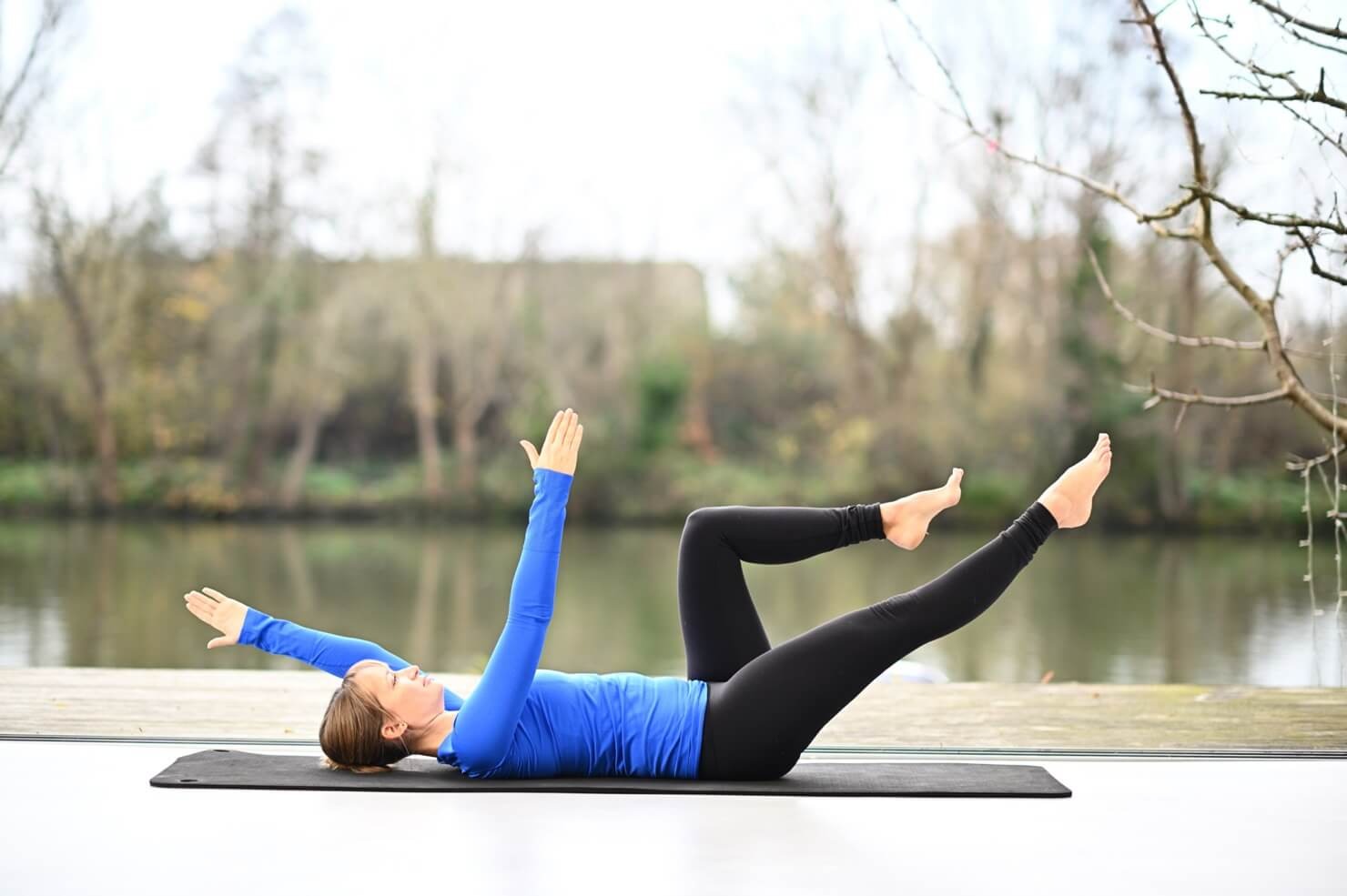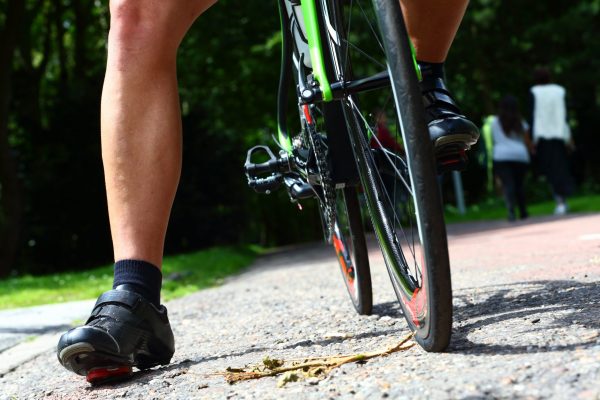

Featured
What Is A Dead Bug Exercise
Modified: January 2, 2024
Discover the benefits of the featured dead bug exercise and learn how to perform it properly for a stronger core and improved stability.
Introduction
The Dead Bug exercise is a highly effective core strengthening exercise that has gained popularity in recent years. It may sound like a strange name for an exercise, but don’t let that fool you. The Dead Bug exercise is a fundamental movement that targets the deep abdominal muscles and promotes stability throughout the entire core.
So, what exactly is the Dead Bug exercise? In simple terms, it is a floor-based exercise where you lie on your back, extend your arms towards the ceiling, and lift your legs, mimicking the movement of a dead bug. This exercise may initially seem easy, but don’t be deceived. It requires precise technique and control to perform it correctly and reap the maximum benefits.
The Dead Bug exercise is a go-to exercise for fitness enthusiasts, athletes, and anyone looking to develop a stronger and more stable core. It offers a range of benefits, including improved posture, enhanced athletic performance, and reduced risk of back pain and injuries.
In this article, we will explore the technique and form of the Dead Bug exercise, discuss variations and progressions, highlight its numerous benefits, and provide tips on how to avoid common mistakes. Whether you are a beginner or an experienced fitness enthusiast, this article will serve as a comprehensive guide to help you incorporate the Dead Bug exercise into your workout routine for optimal results.
Overview of the Dead Bug Exercise
The Dead Bug exercise is a core strengthening exercise that primarily targets the deep core muscles, including the rectus abdominis, transverse abdominis, and obliques. It is a popular exercise among fitness enthusiasts, athletes, and physical therapists due to its ability to improve core stability, posture, and overall body strength.
Unlike traditional core exercises such as crunches or sit-ups, which primarily focus on the superficial abdominal muscles, the Dead Bug exercise engages the deeper layers of the core. This is achieved by performing a controlled movement that involves simultaneously extending the opposite arm and leg while maintaining a neutral spine position.
The primary goal of the Dead Bug exercise is to improve core stability, which is essential for maintaining proper body alignment, preventing injuries, and enhancing athletic performance. It targets the muscles responsible for stabilizing the spine, pelvis, and hips, creating a solid foundation for functional movements.
In addition to core stability, the Dead Bug exercise also helps to improve coordination, balance, and body awareness. As you alternately extend each arm and leg, you challenge your ability to maintain control and synchronization, leading to increased neuromuscular efficiency.
Another key benefit of the Dead Bug exercise is its ability to enhance postural alignment. By engaging the deep core muscles, it helps to counteract the negative effects of prolonged sitting and poor posture, which can lead to musculoskeletal imbalances and pain. Regular practice of the Dead Bug exercise can improve spinal alignment, reduce back pain, and improve overall posture.
Although the Dead Bug exercise primarily targets the core muscles, it also engages other muscle groups, including the glutes, hip flexors, and shoulder stabilizers. This comprehensive activation of multiple muscle groups makes it a highly effective compound exercise.
When performed correctly, the Dead Bug exercise can provide a solid foundation for more advanced core exercises and functional movements. It is suitable for all fitness levels and can be modified to accommodate individual abilities and goals.
In the following sections, we will delve into the specifics of the Dead Bug exercise, including its proper technique and form, variations and progressions, and the many benefits it has to offer.
Technique and Form
The Dead Bug exercise may appear deceptively simple, but proper technique and form are crucial for maximizing its benefits and preventing injury. Here’s a step-by-step guide on how to perform the Dead Bug exercise with correct form:
- Start by lying on your back on a mat or comfortable surface. Bend your knees and position them at a 90-degree angle, with your feet flat on the floor. Your arms should be extended straight up towards the ceiling.
- Engage your core by pulling your belly button towards your spine. This will help create stability in your midsection throughout the exercise.
- Gently press your lower back into the mat to maintain a neutral spine position. Avoid arching your back or allowing it to lift off the ground.
- Take a deep breath in, and as you exhale, slowly extend your right arm overhead while simultaneously straightening your left leg and lowering it towards the ground. Keep both your arm and leg a few inches off the floor.
- Return your right arm and left leg back to the starting position while maintaining control and tension in your core muscles.
- Repeat the movement on the opposite side, extending your left arm overhead and your right leg towards the ground.
When performing the Dead Bug exercise, it’s important to focus on the following key points:
- Control: Slow and controlled movements are essential for proper form and maximum engagement of the core muscles. Avoid any swinging or jerking motions.
- Breathing: Remember to breathe throughout the exercise. Inhale during the starting position, and exhale as you extend your arm and leg.
- Core Engagement: Maintain constant engagement of your core muscles throughout the exercise. Imagine drawing your belly button towards your spine to activate your deep abdominal muscles.
- Neutral Spine: Keep your lower back pressed into the mat to maintain a neutral spine position. Avoid arching or rounding your back.
- Alignment: Ensure that your knees are positioned directly over your hips and your arms are aligned with your shoulders. This helps maintain proper alignment and reduces the risk of strain or discomfort in other areas of the body.
It’s important to start with a slow and controlled pace and gradually increase the difficulty as you become more comfortable with the exercise. Quality of movement and proper form should always take precedence over quantity.
Now that we have covered the technique and form of the Dead Bug exercise, let’s explore some variations and progressions that can further challenge your core muscles and help you achieve your fitness goals.
Variations and Progressions
The Dead Bug exercise is versatile and can be modified to suit different fitness levels and goals. Here are some variations and progressions to challenge your core muscles and continue your fitness journey:
- Single Arm or Single Leg: Once you have mastered the basic Dead Bug exercise, you can progress by focusing on one arm or one leg at a time. This increases the demand on your core muscles and challenges your balance and stability.
- Weighted Dead Bug: To add an extra challenge, you can hold a dumbbell, kettlebell, or medicine ball in your hands as you perform the Dead Bug exercise. This increases the resistance and further engages your core muscles.
- Opposite Arm and Leg Reach: Instead of extending the same side arm and leg, challenge yourself by extending the opposite arm and leg simultaneously. This requires more coordination and balance, engaging additional muscle groups.
- Reverse Dead Bug: In this variation, you start with your arms by your sides and your legs straight up towards the ceiling. Lower one leg towards the ground while keeping the other leg stable. This variation targets the lower abdominals and hip flexors.
- Stability Ball Dead Bug: Performing the Dead Bug exercise on a stability ball adds an element of instability, requiring greater core activation and balance. Place the stability ball under your lower back while performing the exercise as described earlier.
- Banded Dead Bug: For increased resistance, you can loop a resistance band around your feet and hold the ends in your hands. This adds tension to the movement and engages your muscles even more.
Remember to gradually increase the difficulty and progression of the exercises as your core strength improves. It’s important to listen to your body and only progress when you can maintain proper form and control.
By incorporating these variations and progressions into your workout routine, you can continue to challenge your core muscles, improve your stability, and achieve new levels of strength and endurance.
Now that we have explored the variations and progressions of the Dead Bug exercise, let’s move on to discussing its numerous benefits.
Benefits of the Dead Bug Exercise
The Dead Bug exercise offers a multitude of benefits for individuals of all fitness levels. Let’s take a closer look at the key advantages of incorporating the Dead Bug exercise into your workout routine:
- Core Strength: The Dead Bug exercise primarily targets the deep core muscles, including the rectus abdominis, transverse abdominis, and obliques. By engaging these muscles, it helps to build a strong and stable core, which is essential for maintaining proper posture, preventing injuries, and enhancing overall body strength.
- Improved Stability: As you perform the Dead Bug exercise, you challenge your body’s ability to maintain stability and control. This exercise targets the muscles responsible for stabilizing the spine, pelvis, and hips, promoting better balance and coordination in everyday movements and athletic activities.
- Enhanced Posture: Regular practice of the Dead Bug exercise can help improve your posture by strengthening the deep core muscles that support the spine. It counteracts the negative effects of prolonged sitting and poor posture, helping to align the spine and reduce back pain.
- Reduced Risk of Injuries: A strong core is essential for injury prevention, especially in activities that involve lifting, twisting, and bending. The Dead Bug exercise targets the muscles involved in stabilizing and supporting the spine, reducing the risk of back injuries during daily activities and sports.
- Improved Athletic Performance: A strong and stable core is crucial for optimal athletic performance. The Dead Bug exercise helps to develop core strength, which translates into improved power, balance, and agility, benefiting athletes in various sports and physical activities.
- Enhanced Body Awareness: The Dead Bug exercise requires coordination and body awareness. By performing controlled movements and engaging different limbs, you improve proprioception and kinesthetic awareness, allowing you to move more efficiently and effectively.
Due to its versatility and effectiveness, the Dead Bug exercise is often recommended by physical therapists and trainers as part of rehabilitation programs for those recovering from back injuries or seeking to improve core stability.
By incorporating the Dead Bug exercise into your fitness routine, you can reap these benefits and achieve a stronger, more stable core, improved posture, and enhanced athletic performance.
Now that we understand the benefits of the Dead Bug exercise, let’s discuss some common mistakes to avoid to ensure you are getting the most out of this exercise.
Common Mistakes and How to Avoid Them
Although the Dead Bug exercise is relatively straightforward, there are common mistakes that can hinder its effectiveness and potentially lead to injury. By being aware of these mistakes and knowing how to avoid them, you can ensure that you perform the exercise correctly and safely. Here are some common mistakes to watch out for:
- Arching or Rounding the Back: One of the most common mistakes during the Dead Bug exercise is allowing the lower back to arch or round. This not only reduces the activation of the core muscles but also puts strain on the spine. To avoid this, focus on keeping your lower back pressed into the mat and maintaining a neutral spine throughout the movement.
- Lifting the Head and Shoulders: Another mistake is lifting the head and shoulders off the mat. This can cause tension in the neck and shoulders and take the focus away from the core muscles. Instead, keep the head and shoulders relaxed and support them by engaging the core muscles.
- Rushing the Movement: Performing the Dead Bug exercise too quickly or with momentum diminishes its effectiveness. To get the most out of the exercise, focus on slow and controlled movements, emphasizing proper form and engaging the core muscles throughout the entire range of motion.
- Failing to Engage the Core: The Dead Bug exercise is designed to target the core muscles, so it’s crucial to engage them properly. Remember to draw your belly button towards your spine throughout the exercise to activate the deep abdominal muscles and maintain stability.
- Not Maintaining Proper Limb Position: It’s important to keep the limbs in the correct position during the Dead Bug exercise. Avoid fully extending the limbs or allowing them to touch the ground. Instead, aim to keep a slight distance between the limbs and the floor to maintain tension in the core muscles.
- Forgetting to Breathe: Breathing plays a significant role in any exercise. Many people tend to hold their breath during the Dead Bug exercise, which can lead to unnecessary tension and reduce the effectiveness of the movement. Remember to breathe continuously and exhale as you extend the opposites arm and leg.
To avoid these common mistakes and get the most out of the Dead Bug exercise, focus on maintaining proper form, engaging the core muscles, and performing the movements slowly and with control. It can be helpful to perform the exercise in front of a mirror or with the guidance of a trained fitness professional to ensure you are executing it correctly.
Now that we have covered the common mistakes and how to avoid them, let’s discuss some precautions and considerations to keep in mind when practicing the Dead Bug exercise.
Precautions and Considerations
As with any exercise, it’s important to take certain precautions and consider individual factors before incorporating the Dead Bug exercise into your workout routine. Here are some important precautions and considerations to keep in mind:
- Injury or Pre-existing Conditions: If you have any pre-existing injuries or conditions that affect your core or spine, such as herniated discs or abdominal strains, it’s crucial to consult with a healthcare professional or a qualified fitness trainer before attempting the Dead Bug exercise. They can assess your condition and provide guidance on whether this exercise is suitable for you.
- Proper Warm-up: Like any exercise, it’s essential to warm up your body before performing the Dead Bug exercise. This helps to prepare your muscles and joints for the movements and reduces the risk of strain or injury. Incorporate dynamic stretches and movements to get your body warmed up and increase blood flow to the relevant muscles.
- Progression: Start with the basic Dead Bug exercise and gradually progress to more challenging variations. Trying to perform advanced variations before mastering the foundational movement can increase the risk of improper form and injury. Take your time to build core strength and control before advancing to more complex variations.
- Quality Over Quantity: It’s essential to prioritize quality of movement over the number of repetitions or sets performed. Focus on maintaining proper form and engaging the targeted muscles throughout the exercise. Performing the Dead Bug exercise with poor form can lead to ineffective results and potential strain on other areas of the body.
- Listen to Your Body: Pay attention to how your body feels during the Dead Bug exercise. If you experience pain, discomfort, or excessive strain, it’s important to stop and reassess your technique. Modify or reduce the intensity as needed, and consult a professional if the discomfort persists.
- Breathing Pattern: Proper breathing is crucial during the Dead Bug exercise. Remember to inhale during the starting position and exhale as you extend the opposing arm and leg. Focus on deep breaths and avoid holding your breath, as this can create unnecessary tension in the body.
- Individual Fitness Level: The Dead Bug exercise can be modified to suit different fitness levels. Start at a level that is appropriate for your current strength and ability, and gradually progress as you become more comfortable and stronger. It’s important to work within your own limits and avoid comparing yourself to others.
By taking these precautions and considering individual factors, you can ensure that you perform the Dead Bug exercise safely and effectively. Always prioritize your well-being and listen to your body’s feedback during the exercise.
Now that we have discussed the precautions and considerations, let’s explore how to incorporate the Dead Bug exercise into your workout routine.
Incorporating the Dead Bug Exercise into Your Workout Routine
Now that you’re familiar with the Dead Bug exercise and its benefits, it’s time to consider how to incorporate it into your workout routine. Here are some tips for effectively adding the Dead Bug exercise into your fitness regimen:
- Frequency: Aim to perform the Dead Bug exercise 2-3 times per week. This frequency allows for sufficient rest and recovery between sessions while still providing consistent stimulation for your core muscles.
- Duration: Start with a duration that challenges you but allows you to maintain proper form. Begin with 2-3 sets of 8-10 repetitions per side and gradually increase the volume as your core strength improves.
- Warm-up: Always begin your workout with a proper warm-up. Incorporate some light cardio exercises, followed by dynamic stretches and mobility exercises to prepare your body for the Dead Bug exercise and minimize the risk of injury.
- Placement in Your Workout: The Dead Bug exercise is an effective core exercise that can be performed at the beginning or the end of your workout. Placing it at the beginning allows you to focus on form and technique when your muscles are fresh, while incorporating it at the end can serve as a challenging finisher to your training session.
- Progression: As your strength and proficiency increase, gradually progress to more challenging variations of the Dead Bug exercise. This can include incorporating weights, adding resistance bands, or trying stability ball variations. Continually challenging your muscles helps to promote growth and development.
- Combining with Other Exercises: The Dead Bug exercise can be combined with other core exercises, such as planks, bird dogs, or Russian twists, to create a comprehensive core workout. Mixing exercises that target different aspects of the core can provide a well-rounded training session.
- Listen to Your Body: Pay attention to how your body responds to the Dead Bug exercise. If you ever experience pain or discomfort, it’s important to modify the exercise or consult a fitness professional for guidance. Everyone’s body is unique, so adjust the intensity and progression based on your individual capabilities and limitations.
Remember, consistency is key when incorporating the Dead Bug exercise into your workout routine. Over time, you’ll notice improvements in core strength, stability, and overall fitness. So, be patient and stay committed to your routine.
Now that we have discussed how to incorporate the Dead Bug exercise into your workout routine, let’s take a look at a sample Dead Bug exercise routine to give you some practical guidance.
Sample Dead Bug Exercise Routine
Here is a sample Dead Bug exercise routine that you can incorporate into your workout routine. This routine focuses on gradually progressing through different variations of the Dead Bug exercise:
Phase 1: Foundation
- Start with the basic Dead Bug exercise, performing 2 sets of 8-10 reps per side.
- Focus on maintaining proper form and engaging your core throughout the movement.
- Take your time to feel comfortable and confident with the exercise before moving on to the next phase.
Phase 2: Progression
- Single Arm Dead Bug: Perform 2 sets of 8-10 reps per side, focusing on stability and control.
- Opposite Arm and Leg Reach: Perform 2 sets of 8-10 reps per side, emphasizing coordination and balance.
- Repeat Phase 2 exercises for 4-6 weeks, gradually increasing the difficulty by adding more reps or sets as needed.
Phase 3: Advanced Variations
- Weighted Dead Bug: Incorporate weights, such as dumbbells or a medicine ball, and aim for 2-3 sets of 8-10 reps per side.
- Stability Ball Dead Bug: Perform 2-3 sets of 8-10 reps, using a stability ball to challenge your core stability and balance.
- Banded Dead Bug: Incorporate a resistance band around your feet, and perform 2-3 sets of 8-10 reps per side.
- Continue progressing and challenging yourself with more advanced variations as your strength and proficiency improve.
Remember to always prioritize proper form, engage your core, and listen to your body. Adjust the intensity and progression as needed to suit your fitness level and goals.
Additionally, it’s important to combine the Dead Bug exercise routine with other exercises that target different muscle groups and aspects of fitness. This will help create a well-rounded workout routine that promotes overall strength, stability, and endurance.
Now that we have explored a sample Dead Bug exercise routine, let’s summarize the key points of this article.
Conclusion
The Dead Bug exercise is a highly effective core strengthening exercise that targets the deep core muscles and promotes stability throughout the entire core. By incorporating this exercise into your workout routine, you can experience a wide range of benefits, including improved core strength, enhanced stability, better posture, reduced risk of injuries, improved athletic performance, and increased body awareness.
When performing the Dead Bug exercise, it’s essential to focus on proper technique and form. Avoid common mistakes such as arching or rounding the back, lifting the head and shoulders, rushing the movement, neglecting core engagement, and forgetting to breathe. By paying attention to these details, you can optimize the effectiveness of the exercise while minimizing the risk of injury.
As you progress in your Dead Bug exercise journey, consider incorporating variations and progressions to constantly challenge your core muscles. This can include single arm or single leg variations, weighted Dead Bug, stability ball Dead Bug, and banded Dead Bug. Remember to progress gradually and listen to your body to ensure that you are pushing yourself within your limits.
Before starting any new exercise program, it’s important to take precautions and consider individual factors. If you have pre-existing conditions or injuries, consult with a healthcare professional or a qualified fitness trainer to determine if the Dead Bug exercise is appropriate for you. Additionally, remember to warm up properly, prioritize quality over quantity, and always listen to your body’s cues.
Incorporating the Dead Bug exercise into your workout routine can be a valuable addition to your fitness journey. By following the sample Dead Bug exercise routine and combining it with other core exercises, you can create a well-rounded workout routine that targets various muscle groups and aspects of fitness.
So, get ready to strengthen your core, improve stability, and enhance your overall fitness with the Dead Bug exercise. Start slowly, progress at your own pace, and enjoy the benefits of this simple yet powerful core strengthening exercise!






